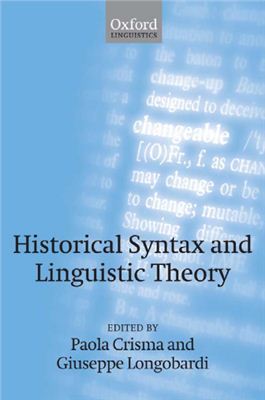Pages: 432
Publisher: Oxford University Press (2009)
Quality: good: pdf
This book of new work by leading inteational scholars considers developments in the study of diachronic linguistics and linguistic theory, including those conceed with the very definition of language change in the biolinguistic framework, parametric change in a minimalist conception of grammar, the tension between the observed gradual nature of language change and the binary nature of parameters, and whether syntactic change can be triggered inteally or requires the exteal stimuli produced by phonological or morphological change or through language contact. It then tests their value and applicability by examining syntactic change at different times and in a wide range of languages, including German, Chinese, Dutch, Sanskrit, Egyptian, Norwegian, old Italian, Portuguese, English, the Benue-Kwa languages of Niger-Congo, Catalan, Spanish, and old French. The book is divided into three parts devoted to (i) theoretical issues in historical syntax; (ii) exteal (such as contact and interference) and inteal (grammatical) sources of morphosynactic change; and (iii) parameter setting and reanalysis.
ISBN 978–0–19–956054–7
Publisher: Oxford University Press (2009)
Quality: good: pdf
This book of new work by leading inteational scholars considers developments in the study of diachronic linguistics and linguistic theory, including those conceed with the very definition of language change in the biolinguistic framework, parametric change in a minimalist conception of grammar, the tension between the observed gradual nature of language change and the binary nature of parameters, and whether syntactic change can be triggered inteally or requires the exteal stimuli produced by phonological or morphological change or through language contact. It then tests their value and applicability by examining syntactic change at different times and in a wide range of languages, including German, Chinese, Dutch, Sanskrit, Egyptian, Norwegian, old Italian, Portuguese, English, the Benue-Kwa languages of Niger-Congo, Catalan, Spanish, and old French. The book is divided into three parts devoted to (i) theoretical issues in historical syntax; (ii) exteal (such as contact and interference) and inteal (grammatical) sources of morphosynactic change; and (iii) parameter setting and reanalysis.
ISBN 978–0–19–956054–7

